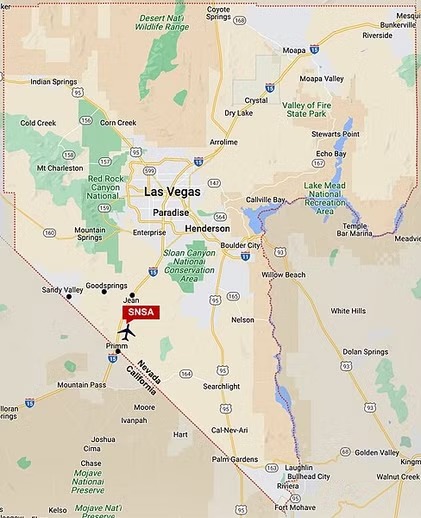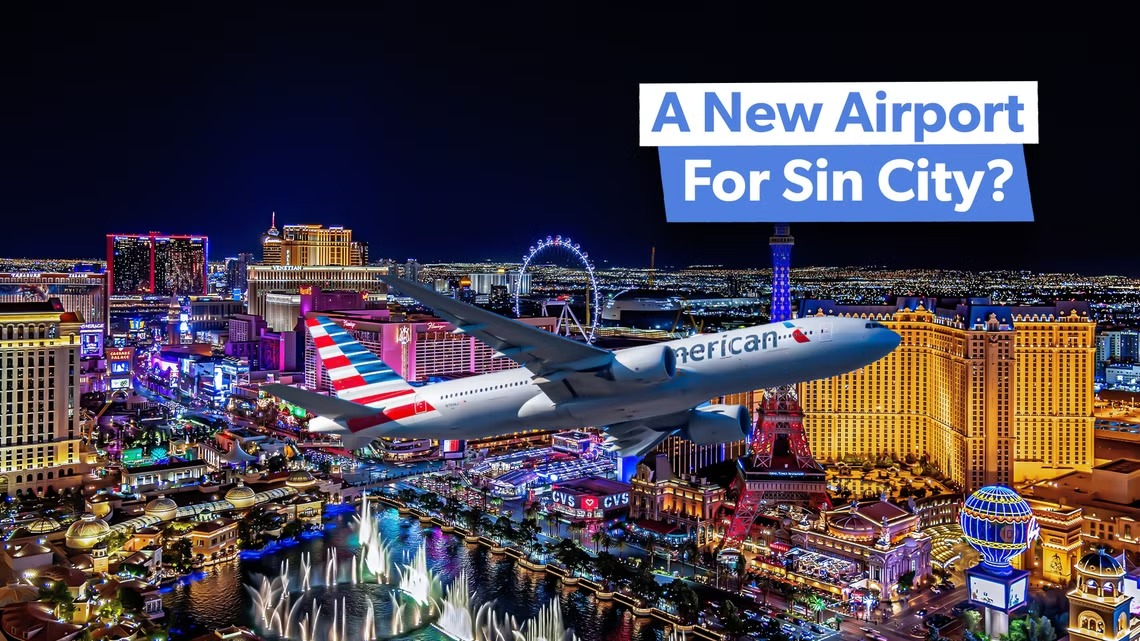Currently known as the Southern Nevada Supplemental Airport, thew new airport would be located 23 miles south of the Las Vegas Strip, near Jean and Primm, in Clark County, Nevada. Once completed, it could accommodate some of the largest commercial aircraft currently in operation and would rival other airports, such as Denver International Airport and Dallas/Fort Worth International Airport, in terms of land area.


Southern Nevada Supplemental Airport
Intended to offer substantial new long-term aviation capacity for the wider Las Vegas metropolitan area, the state of Nevada, and surrounding regions in California and Arizona, the new airport site already covers over 6,000 acres, with 17,000 additional acres set aside as a buffer as the airport grows.
Becoming a second airport for Las Vegas will complement the current landlocked Las Vegas Harry Reid International Airport, which is nearing its capacity as the city’s travel demand continues to soar. Not only is Las Vegas a popular tourist destination, but with growing conference, sports, and business, the city’s current airport is already one of the busiest in North America.


In addition to the airport development, an upgrade to the I-15 South Corridor would be developed. Improving the current freeway from six lanes to 14 would mean that increased traffic would see the airport having dedicated ramps, ensuring seamless travel from the city center. Light rail, trams, and bus routes are also being considered.
Las Vegas’ current airport will reach capacity by 2030
According to the Clark County Department of Aviation, the current Harry Ried International Airport (LAS) will surpass its full capacity of 63 million passengers annually by the decade’s end. So, the Clark County Department of Aviation has teamed up with the Bureau of Land Management and FAA to establish a new airport development.

For Southern Nevada Supplemental Airport, the groundwork is still a while away. Only this year did the Clark County Board of Commissions approve a $1 million contract to prepare an environmental impact statement on where the new airport would be located and the advantages and disadvantages of the development. Should Southern Nevada Supplemental Airport go ahead, it would be the largest single public works project in history within the state and would cost between $6 and $14 billion to develop and build.
Up to 153 gates and two runways
Initial plans have identified that the airport would feature multiple terminals spread across the 23,000-acre site and would feature two runways. 18R-36L would be one of the longest civil runways in all of the United States:
| RWY 18L-36R | RWY 18R-36L | |
|---|---|---|
| Length | 12,000 feet | 15,000 feet |
| Width | 150 feet | 200 feet |
According to Macrotrends, the current population of the Las Vegas metropolitan area is almost three million, and it has grown by nearly 2% year on year since 2021. However, add in the 40 million tourists visiting the region each year, and you can start to explain why a new airport development is being considered.

Source: VanillaSea | Wikimedia Commons
For those not visiting Las Vegas, it’s not just about the bright lights and gambling. Las Vegas is renowned for its fabulous entertainment venues, shows, bars, restaurants, and shopping. While the razzle-dazzle of the Las Vegas strip can become addictive, those looking for peace don’t have to venture far. Las Vegas is also one of the gateways to four nearby parks:
- Red Rock Canyon National Conservation Area
- Lake Mead National Recreation Area and the Hoover Dam
- Death Valley National Park
- Valley of Fire State Park
LAS is currently a stone’s throw from the Las Vegas strip
Harry Reid International Airport, which was formerly known as McCarran International Airport, is conveniently located just four miles from downtown Las Vegas. Those fortunate enough to have a window seat onboard will spot the bright lights, high-rise buildings, and sprawling cityscape as you come into the land. The airport has gambling machines throughout the terminal buildings, so you can try your luck in winning big.
Historically, the airport was opened in January 1943 and has been operating for 81 years. Today, the airport is an operating base for Allegiant Air, Frontier, JSX, Southwest, and Spirit Airlines and provides an extensive list of domestic destinations with all major US carriers. Its international network is also growing rapidly, even seen in the last quarter of 2024, as it will welcome these new services:
- Aer Lingus with seasonal flights to Dublin
- Aeromexico to Guadalajara and Monterrey
- Air Canada resuming direct flights to Montreal
- Porter Airlines operating to Ottawa and Montreal
- Viva Aerobus to Guadalajara
- Volaris to Tijuana
According to KSNV Las Vegas, in 2023, the airport saw 57.6 million passengers travel through the current airport’s doors, recording 612,000 aircraft movements. Not only is the airport a busy destination for travelers, but cargo as well, with 263 million pounds of freight arriving and departing from the airport.
Top destinations from LAS
Between August 2023 and July 2024, the airport’s most popular routes, according to the Bureau of Transportation Statistics, are Los Angeles (1.34 million), Denver (1.18 million), and Dallas/Fort Worth (967,000) passengers. Southwest Airlines remains the largest at the airport, maintaining 40.65% by market share. This represents 21,423,000 passengers annually, and its closest rival is Spirit Airlines, with almost eight million passengers at a 15% share.
Source: Simple Flying

Warning: Illegal string offset 'cookies' in /home/u623323914/domains/eng.bayviet.com.vn/public_html/wp-includes/comment-template.php on line 2564